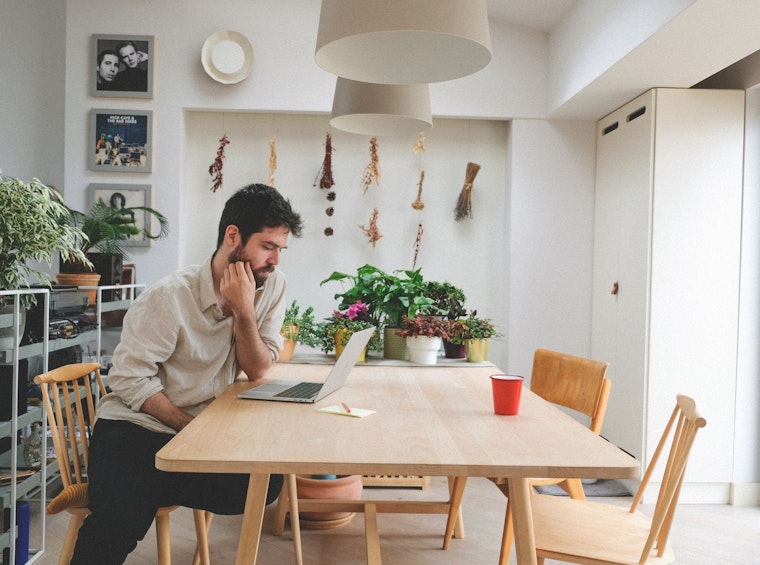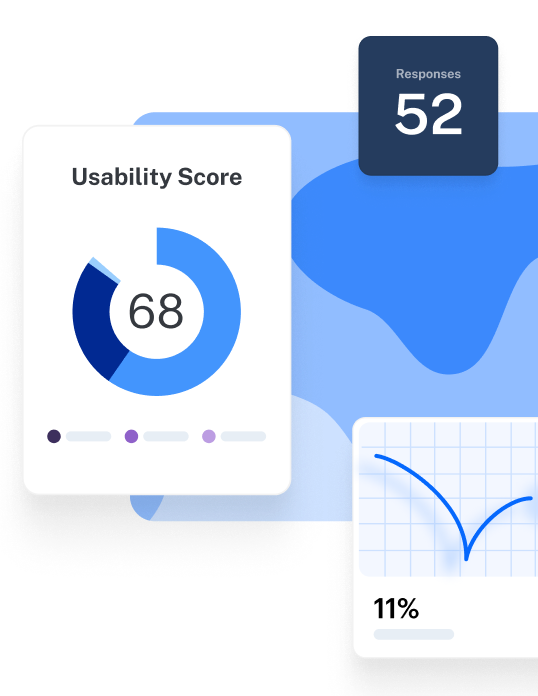Beyond technical expertise, soft skills help UX designers craft intuitive user experiences. From design thinking to effective communication skills and empathy–these skillsets help UX designers better understand user needs and, ultimately, make design choices that align perfectly with user expectations.
To understand the must-have UX designer soft skills for success, we spoke with Gabriel Kirmaier, a prominent UX Designer and the mind behind the Instagram account @uxbites.
Let’s start with a brief introduction. What’s your previous work experience? And what do you do now?
Hi everyone! My name is Gabriel, and I’m a UX designer working remotely with US-based companies. In the last seven years, I’ve worked both with well-funded companies and small startups. Over the years, I thought I would run out of challenges at some point, but I realized that’s never going to happen. I continue to be interested in UX/UI design!

At the moment, I share my UX knowledge on Instagram under the name UX Bites (@uxbites), and I’ve recently published a book about UX design with the same name. The book offers bites of UX information in an easy to digest format.
When we learn from the user, we make better products.
Share
Tell us about your journey. How did you get into design and when did you know it’s something you want to do?
I started in advertising while looking for a creative position that would challenge me. While advertising was all of that, it was also very stressful because of the overtime and unreasonable clients. So, I started looking for similar challenges in a more relaxed environment. I was always drawn to digital projects, so that was an easy switch for me. I began to learn design, and I worked as much as I could. This time, I felt good about the extra effort.
When I started, UX design wasn’t as popular as it is now. For me, it always comes naturally to ask as many questions as possible and base my decisions on all the information I can get. I love design because it implies critical thinking, and they go hand in hand.
Congratulations on the launch of your book! Where did the idea for come from?
The idea for the book came from two things. One is the overwhelming support I get from the people in my UX Bites community. This project started as a hobby, and everyone’s support encouraged me to take up new challenges.
The second reason for the book is my desire to have something like this published. The book comes in a colored, hardcover format, and I love having it on my coffee table and browsing it whenever I need inspiration or ideas.
I think that a book about User Experience Design should embody the approach it advocates: It should be user-friendly and functional, and that’s what I tried to achieve.
You wrote that your motto is “Usability testing is the best way to argue with yourself.” Why is that?
I think UX design is one of the few design fields that appreciates and welcomes feedback, making it receptive to user needs—and that’s absolutely fantastic. When we learn from the user, we make better products. Even if you have strong opinions about something, you can change your mind, and design principles through user testing with real people.
What are ten UI/UX design soft skills you think every designer should know?
1. Curiosity
Ask as many questions as possible. Talk with users via user interviews or surveys to understand them, and don’t be afraid to ask even the most obvious questions. You might be surprised by the unexpected answers you’ll receive.
The best UX designers are curious, interested in people’s behavior, and look to understand the reasons behind users’ actions.
Share
Keep that curiosity alive throughout your design process. When you’re drafting wireframes or rapid prototyping, ask: Why this layout? How does this feature meet a user need? Is there a simpler, more intuitive way?
Even after you launch your final product, gather feedback and then ask more questions. What worked? What didn't? Why? This cycle of questioning, testing, and refining keeps your interface design relevant and meets user needs.
2. Critical thinking
Don’t build on assumptions. Making assumptions means believing things are a certain way with little to no evidence–a practice that doesn’t align with the fundamentals of UX design. Being critical ensures you’re addressing real user needs rather than hypothetical scenarios.
Critical thinking also extends to problem-solving. When faced with design challenges, don't jump to the first solution that comes to mind. Instead, consider multiple solutions and weigh their pros and cons based on user impact, feasibility, and alignment with the project goals.
3. Analytical thinking
Test and validate your ideas. Many of us have had moments when we come up with what we think is a great idea, and we’re ready to jump in and start prototyping, wireframing, or creating visual designs with tools like Figma.
This means breaking down user feedback into actionable insights. You need to segment user data, identify patterns, or even discover biases that prompt a re-evaluation of your design assumptions.
4. Adaptability and flexibility
Design with people’s mental models in mind. People spend a lot of their time online using different websites and apps, so they expect yours to work similarly. Don’t reinvent the wheel just for the sake of it! Validate your ideas through usability testing and user research.
UX research methods like card sorting are a good way to understand people’s mental models, but you can also gather this insight through user interviews or research questions.
5. Problem analysis
What people say and what they do can be totally different. User interviews are essential to the design process, but it’s also important that you do observational user research, like field studies, to better understand user behavior. Active listening and empathy can help you refine the user interface and product design.
6. Empathy
Don’t think features, think user needs. This means starting with the specific problems and needs users have and trying to solve those with product solutions—and not the other way around.
Conduct user interviews, observe them in their natural environment, and put yourself in your user’s shoes to experience the pain points firsthand. This way, you create a more inclusive design process that takes into account diversity–be it age, gender, cognitive ability, or cultural background.
7. Active listening
Be open-minded, listen, empathize. It’s impossible not to have assumptions—that’s how our brain works. Engage with users during interviews or user testing sessions with a focus on their perspectives. The important thing is to listen, be open-minded, and accept when we’re wrong.
8. Strategic thinking
Understand business requirements as much as users. Learning what the business goals are is as important as understanding your target users. When you have a view of the whole picture, you’ll be less prone to build what you think is required and design or iterate solutions that address actual needs.
9. Technical literacy
Embrace the technical side to understand how products are built. You don’t need the technical skills of a developer to be a great designer, but you should understand how the technology works and what its possibilities and limitations are. For instance, user experiences should be built with performance in mind, and knowing what performance is and how to optimize it will help you build great products.
10. Collaboration and teamwork
Be a team player. Your team’s common goal is to build a great product. As a designer, you need to put your ego aside and know that your team members work towards this goal. This requires you to collaborate with fellow designers but also with product and project managers, developers, and others.
Additional UX designer soft skills
In addition to Gabriel's top soft skills, we also suggest these UX designer soft skills:
- Time management and prioritization: Manage your time like a pro. Deadlines are always around the corner. Prioritize your tasks, from creating mockups to optimizing functionality, ensuring you meet deadlines without compromising on quality. Effective time management means delivering on time, every time, without last-minute panic.
- Reliance and perseverance: Design doesn't always go right the first time. When faced with challenges or negative feedback during user testing, take it in stride. Use it to refine and iterate your designs, pushing toward perfection with persistence and resilience.
- Persuasion and negotiation: A great design needs buy-in from stakeholders, team members, and sometimes even users. Articulate the value and reasoning behind your design choices, turning skepticism into support.
- Continuous learning: The UX field is always evolving–new design tools, trends, and methodologies emerge constantly. Dive into podcasts, enroll in online courses, and expand your skill set.
- Attention to detail: Every pixel in your wireframe and every interaction in your prototype matters. Consistency in typography, alignment, and color use enhances usability and aesthetic appeal, making the user experience seamless and enjoyable.
What is one of the most important skills a UX designer should have, in your opinion?
One of the most important abilities a UX designer should have is not being led by their own beliefs and assumptions blindly. UX design is an observational profession, where empathy for the user is your most crucial trait. This user-centric mentality results in digital products that understand and solve people’s pain points instead of simply assuming what users want. The latter usually only creates products nobody uses or cares about.
Ultimately, there are both soft and hard skills for UX designers to master. In my experience, the best UX designers are curious, interested in people’s behavior, and keen to walk in their user’s shoes to understand the reasons behind their actions.
What are some of your favorite design books, podcasts, or resources?
I recently had a great conversation on the Design Huddle podcast and the XD podcast. I enjoyed the casual context of those two podcasts. Other great podcasts are Jake and Jonathan (formally Product Breakfast Club), UI Breakfast, and Wireframe.
As far as books go, you can't go wrong with Don’t Make Me Think by Steve Krugg. Make sure you also don’t skip The Design of Everyday Things by Don Norman. Hooked by Nir Eyal was an eye-opener because it theorizes why people come back to use a product and how it can eventually become a part of their identity.
Where can people find your book?
The book is out now and available worldwide here.
I’m very proud of the book. It turned out to be exactly what I wanted, touching on each UX design subject. If you get yours, tell me what you think!
Frequently asked questions about UX designer soft skills
What are soft skills for UX design?
What are soft skills for UX design?
Soft skills are general traits that aren’t specific to any job or profession. They include characteristics like communication, teamwork, empathy, and time management. Some crucial soft skills in UX include curiosity, critical thinking, empathy, and flexibility.
What skills does a UX designer need?
What skills does a UX designer need?
UX designers need a combination of hard and soft skills to succeed. Hard skills include visual and UI design skills, user research and analysis, and wireframing. Soft skills required for UX design include empathy, collaboration, and teamwork.


